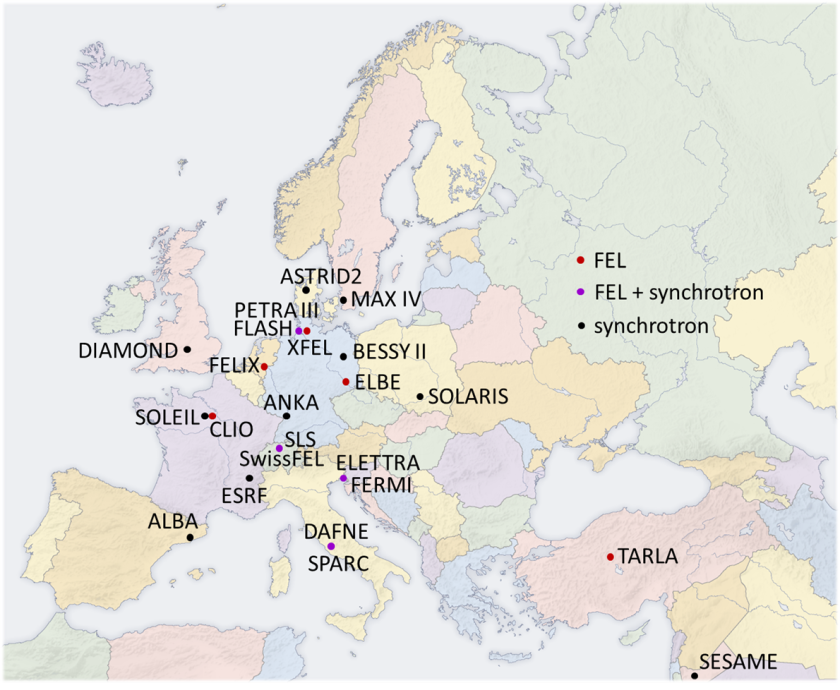EU project CALIPSOplus has started for free access to European light sources

Light sources collaborating in CALIPSOplus
The EU is providing ten million euros in funding for the project CALIPSOplus, submitted by 19 European light sources. The project consortium, of which Helmholtz-Zentrum Berlin is a member, kicked off on May 2017. CALIPSOplus is aimed at promoting the international exchange of scientists and transnational access to the light sources in Europe. Other priorities are to integrate the relatively less active regions of Europe and to initiate research projects with small and mid-sized companies.
CALIPSOplus has a runtime of four years and is coordinated by Helmholtz-Zentrum Dresden-Rossendorf. In the scope of CALIPSOplus, HZB manages the work package “Dissemination and Training” and is involved in the research project MOONPICS on the metrology of nanometre lenses.
The project partners will be taking targeted measures to advertise the outstanding analytical methods available here to researchers from Central and Eastern Europe who have so far rarely used the European light sources. This will help to integrate them more strongly into the European scientific landscape. “It is important that we approach the scientists from these countries in person, locally, and promote the opportunities at the light sources. So it’s great that the training programme is one of the priorities of CALIPSOplus,” says Dr. Antje Vollmer, who is coordinating the activities for HZB and who manages user coordination at HZB. Among other things, HZB is planning workshops at universities of the 13 youngest EU countries. Furthermore, there will be a “twinning and exchange programme” that will invite scientists from these countries to collaborate on an equal footing with experienced users of light sources.
The kick-off event for CALIPSOplus was held at Helmholtz-Zentrum Dresden-Rossendorf (HZDR) on 18 and 19 May 2017. More information
Website Wayforlight
Wayforlight.eu is currently being expanded and provides information about the experimental stations at Europe’s light sources and details on how to apply for measuring time.
(sz)
https://www.helmholtz-berlin.de/pubbin/news_seite?nid=14684;sprache=en
- Copy link
-
Battery research with the HZB X-ray microscope
New cathode materials are being developed to further increase the capacity of lithium batteries. Multilayer lithium-rich transition metal oxides (LRTMOs) offer particularly high energy density. However, their capacity decreases with each charging cycle due to structural and chemical changes. Using X-ray methods at BESSY II, teams from several Chinese research institutions have now investigated these changes for the first time with highest precision: at the unique X-ray microscope, they were able to observe morphological and structural developments on the nanometre scale and also clarify chemical changes.
-
BESSY II: New procedure for better thermoplastics
Bio-based thermoplastics are produced from renewable organic materials and can be recycled after use. Their resilience can be improved by blending bio-based thermoplastics with other thermoplastics. However, the interface between the materials in these blends sometimes requires enhancement to achieve optimal properties. A team from the Eindhoven University of Technology in the Netherlands has now investigated at BESSY II how a new process enables thermoplastic blends with a high interfacial strength to be made from two base materials: Images taken at the new nano station of the IRIS beamline showed that nanocrystalline layers form during the process, which increase material performance.
-
Hydrogen: Breakthrough in alkaline membrane electrolysers
A team from the Technical University of Berlin, HZB, IMTEK (University of Freiburg) and Siemens Energy has developed a highly efficient alkaline membrane electrolyser that approaches the performance of established PEM electrolysers. What makes this achievement remarkable is the use of inexpensive nickel compounds for the anode catalyst, replacing costly and rare iridium. At BESSY II, the team was able to elucidate the catalytic processes in detail using operando measurements, and a theory team (USA, Singapore) provided a consistent molecular description. In Freiburg, prototype cells were built using a new coating process and tested in operation. The results have been published in the prestigious journal Nature Catalysis.
